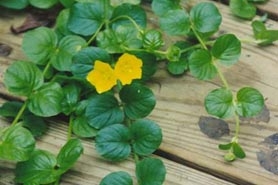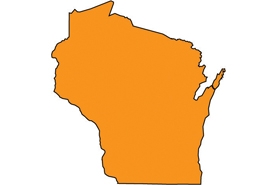Moneywort
(Lysimachia nummularia or L. nummelaria)
Creeping, low-growing perennial with round, opposite leaves and yellow flowers.
Other names for this plant include:
- Common names: Creeping Jenny, creeping Joan, running Jenny, wandering Jenny, wandering sailor
Classification in Wisconsin: Restricted (the cultivar Aurea and yellow and gold leaf forms are exempt).
- Ecological Threat
-
- Invades moist forests, woodland edges, floodplain forests, swamps, wet meadows, fens, stream borders, lawns, roadside ditches and grasslands.
- Moneywort has been known to choke small springs and seeps in rich woods due to its rapid spread and ability to form dense layers.
- This species is capable of rapid vegetative spread that can form dense, low-growing mats.
- This species forms a dense ground cover layer, thereby altering the plant community structure and reducing the population size of some native species in the herb layer.
- Noted as an invasive species throughout much of the United States.
- Identification
-
Leaves & stems: Stem can grow to 2 feet long. Simple leaves with opposite leaf arrangement. Leaves are round and shiny. Stems are smooth, low-growing and trailing. Stems branch frequently to form mat-like growth.
Flowers: Yellow, small and marked with deep red blotches. 5-petaled flowers are born individually on leaf axils. Flowers bloom June to August.
Roots: White and trailing.
- Control
- Mechanical:
- For small infestations, plants may be pulled or dug. Make sure to remove all stems, stem fragments and roots to prevent the stems from rooting again in the soil.
- Prolonged submergence in water will kill moneywort.
- At restoration sites, moneywort can be controlled by establishing native grasses to shade it out.
- In fire-adapted plant communities, controlled burns in the early spring or late fall (when native species are dormant) may be helpful.
- Several herbicides are effective in controlling moneywort; however, because moneywort usually grows in or near wetlands, be sure that the herbicide is aquatically-approved. Rodeo is one such herbicide product that may be effective.
- Resources
- Sources for content:
- USDA, ARS, National Genetic Resources Program. Germplasm Resources Information Network - (GRIN) [Online Database]. National Germplasm Resources Laboratory.
- Czarapata, Elizabeth; Invasive Plants of the Upper Midwest: an illustrated guide to their identification and control. University of Wisconsin Press. 2005. Pg. 112
- USDA Forest Service, Weed of Week: Moneywort.


